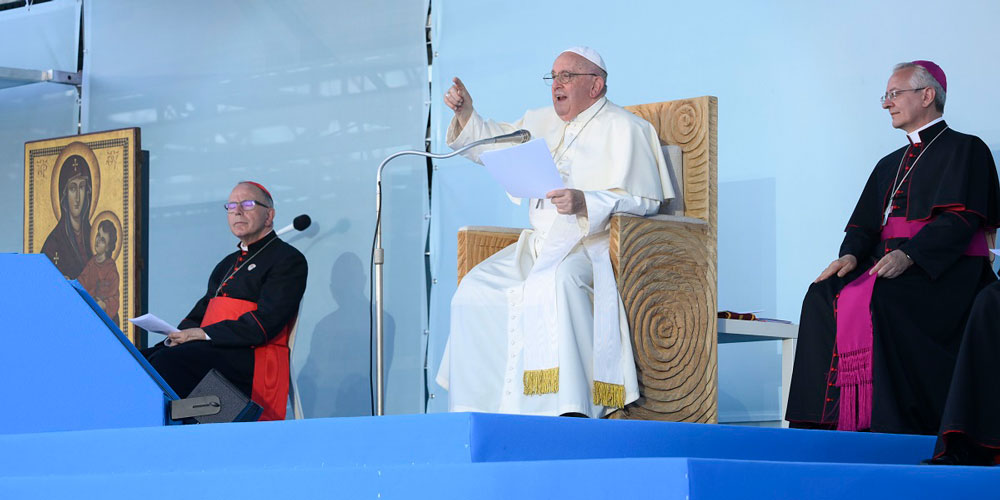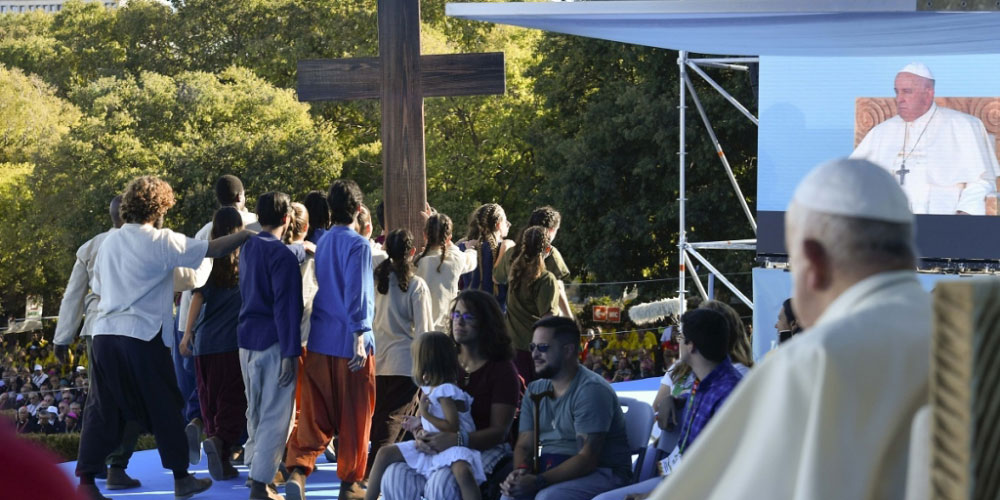The young people of World Youth Day (WYD) formed an imaginary Calvary climbing up and down from the scaffolding that forms the large stage set up on the Meeting Hill in Lisbon's Edward VII Park.
From station to station they carry the cross of Christ aloft. They fall and get up again, as in the building site of life, but they are not alone: Jesus walks with them. This was recalled by Pope Francis, who in his speech urged the 800,000 young people present to say it all: "Jesus walks for me", because "no one has more love than he who gives his life", for his friends and for others.
The Via Crucis, one of the most solemn and moving events of each World Youth Day, was accompanied by traditional and contemporary music, as well as a series of images representing each Station, which were created by a Jesuit artist, Fr. Nuno Branco.
”According to WYD organizers, “the purpose of the Way of the Cross goes far beyond merely recalling the suffering that Christ endured. This type of prayer… proposes that we contemplate and allow ourselves to be infected by the dimension of this totally generous Love, so self-giving as to give his own life for the lives of others.”
Pope Francis in his words of introduction said, “the way that is most engraved in our hearts is the way of Calvary, the Way of the Cross. And today you are going with prayer – we [are going in prayer], me too – with prayer, you are going to renew the Way of the Cross.
Jesus walked all through his life, healing the sick, caring for the poor, teaching and preaching, but it is the way to Calvary that remains deeply etched in the heart of each one. His way "is God going out of himself to walk among us", the Pope reiterates, "and this he does out of love". The same cross that accompanies every WYD, he explains, is the icon of this journey. It is "the greatest meaning of the greatest love", the one "with which Jesus wants to embrace our lives".
At each station, 50 young people from 21 countries around the world, accompanied by a 62-strong choir and 30 instrumentalists, re-enacted the martyrdom of Christ. At various points throughout the journey, young people - from Portugal, Spain, and the United States - offered their own testimonies of suffering, hope, and of love.
 Pope Francis' invitation to young people was to be brave followers of Christ
Pope Francis' invitation to young people was to be brave followers of Christ
Jesus also walks with Caleb, 29 years old from the United States, who bore witness to his struggle with depression, self-harm, and drug addiction until his encounter with Him enabled him to take control of his life without falling back into old habits, and enabled him to meet his wife. He walks with Esther, a 34-year-old Spanish woman who was in a wheelchair after a car accident and who decided with her current husband Nacho to terminate her pregnancy and who now, after the Lord came to seek her out with His great and inexplicable love, is the mother of little Elisabeth. And she walks with João, a 23-year-old Portuguese, bullied and suffering from mental health problems after the lockdown and the pandemic, who through faith has been helped through every fall.
The meditations, written by another Jesuit, Fr. Nuno Tovar de Lemos, were based on the responses of a survey among 20 young people from five continents on what were their greatest concerns. Youth unemployment, war, attacks, mass shootings, religious persecution, exploitation, and even feelings of suicide among youth; various forms of exclusion and intolerance, as well as the isolation, narcissism and misinformation generated by the digital world. Other issues they address are migration, addiction, religious and political persecution, as well as attention to the weak and vulnerable.
There is also a difficulty to love and an inability to act in order to achieve an imposed and self-centred model of happiness. "We are unable to make decisions, nor do we see the direction in which history could continue", they testify: "we only see the path blocked by great obstacles before us".
The Pope's invitation, however, is not to be afraid, because Jesus walks towards the cross and dies on the cross so that our soul can smile. Jesus is with us, "and accompanies us in the darkness that leads us to weeping. He walks and waits with his love, with his tenderness, "to give us consolation, to wipe away our hidden tears with his tenderness". He waits to see "the open windows of our souls".
Christ, he concludes, 'wants to fill our fears with his consolation'. He does this and waits to urge us to embrace 'the risk of loving'. A risk that, the Pope assures us, is always worth taking.

With thanks to ANS for this story

